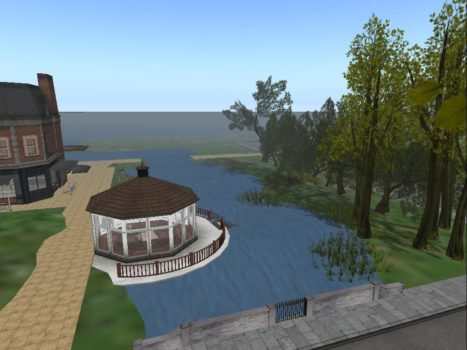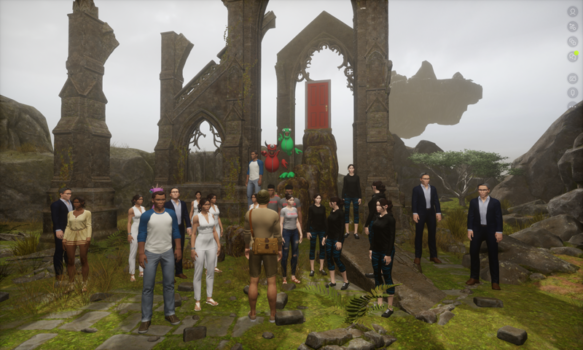
Second Life is moving its architecture to the cloud, Linden Lab announced last week, and that might help them offer lower land prices.
The reason? On-demand cloud-based regions would only be up and running if people are currently visiting them, similar to how the commercial Kitely grid works on the OpenSim platform, an open-source alternative.
Although Second Life did mention that moving to cloud will help them improve performance and could see them offer more products at cheaper prices, they did not release any details about upcoming land offers.
Kitely was in the cloud from the start, when it launched in 2011 and that allowed them to provide server resources only when they are needed, and thus reducing their hosting fees, Kitely CEO Ilan Tochner told Hypergrid Business.
The same could work for Second Life.

“They will likely do so by offering people the option of paying lower tier in exchange for having their regions shut down when not in use,” he said. “They may also try to provide a pay-per-use option like Kitely used to offer, until we discontinued that option in 2015 when we decided that offering it was detrimental to our bottom line.”
Kitely now offers flat-rate packages starting at around $15 per month per region.
Changing the pricing model could also be a strategy to improve margins so that they are able to cover new salary and data center expenses for Sansar, a VR-friendly platform that is not currently bringing in revenues.
“It will be interesting to see how Linden Lab will balance using Second Life as a cash cow for funding their new platform, with offering additional pricing options that can affect their profit margins from second Life,” he said.
Will OpenSim users come back to Second Life?
Many current residents on OpenSim grids started out in Second Life, but moved to OpenSim for lower prices.
They were also drawn by other features, such as lower upload fees and currency exchange rates, larger regions, personal support, custom user management, and region and inventory backups.
“I still maintain that with the talent available within OpenSim grids that OpenSim has a very definite future,” Kea Nation grid owner Don Hayward said in a comment to a post.
But what happens if Second Life doesn’t just lower prices but also increase region sizes and allow exports? That could cause OpenSim users to jump right back, former Second Life creator since 2007 and Virtual Lisbon owner Carlos Loff told Hypergrid Business.

“Many will say — ‘no,’ and many will say, ‘ Second Life never again’,” he admitted. “But if you sit and relax and deeply think about it, the minute they seriously lowered their prices, increased land sizes and allowed OARs, I believe 90 percent of OpenSimers would dive back in Second Life right away.”
Loff has been a creator in Second Life since 2007 before moving to OpenSim but, like many OpenSim users, still has an account in Second Life and visits occasionally.
“For me, the main reason to leave Second Life, and I believe for many others, was the relation of land size verses land fees and OpenSim has a huge strong selling point — ten times more land with ten times less fees,” he said. “No matter which other aspects you bring to the equation, this is the determinant factor at the end of the day.”
Loff himself has three large projects currently underway in OpenSim.
“All this said, and with no offense to many wonderful OpenSim efforts, we must keep recognizing that OpenSim still has a bit of an refugee camp feeling,” he said.
Second Life has significantly more users, content, activities, and commerce, he said.
“They can — yes, they can — wipe out OpenSim in a few months,” he said.
Second Life, in addition to moving to cloud, says it will add features to the environment editor, introduce a grid-wide game experience, allow non-avatar objects to use more powerful and efficient animations, and introduce other creator tools.
Sansar not ready for prime time

Linden Lab’s new Sansar platform, designed around virtual reality from the ground up, was supposed to be the next-generation replacement for Second Life.
However, it’s been criticized for its steep learning curve, poor graphics and lack of collaboration tools.
High Fidelity, is another platform designed for virtual reality, created by Linden Lab founder Philip Rosedale.
In addition, High Fidelity is an improvement in that it has distributed architecture, is open source for both server and client and has better graphics with better shadows, said Lupus Furyo, who creates content for both platforms.
“Sansar was released in such a great rush, the only advantage it may have over High Fidelity is its shades,” he told Hypergrid Business. “The only advantage of Sansar could be, you can run it on a device with less demanding specs.”

Sansar would be better with creator collaborator tools, one Second Life and OpenSim creator told Hypergrid Business.
“The quality of what we have seen in Sansar is amazing, but the tools to make it easy to create are not,” she said, requesting anonymity. “I understand it’s not supposed to be another Second Life, but I would like to see a few things change so we can collaborate because we enjoy working together.”
See Sansar creator preview video below:
- OpenSim active users hit all-time-high for the holidays - December 15, 2023
- OpenSim user activity ramping up for the holidays - November 15, 2023
- OpenSim land area at a new high as grids prep for holidays - October 15, 2023
